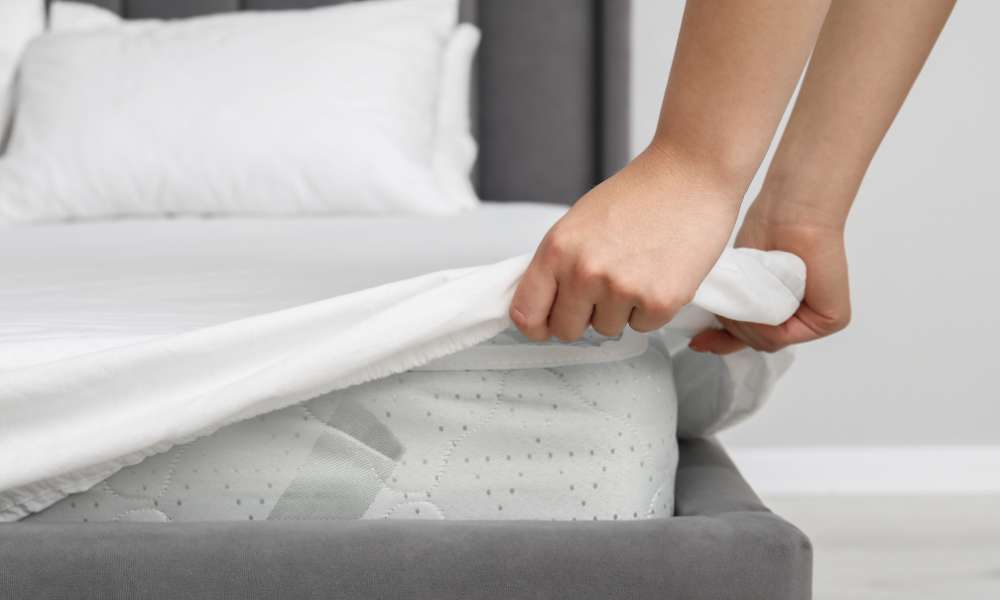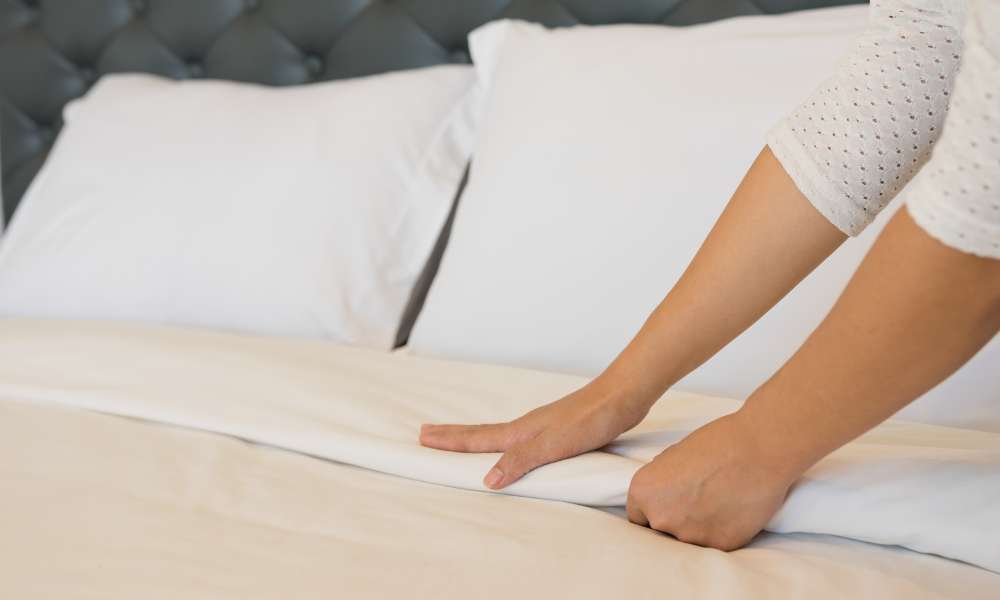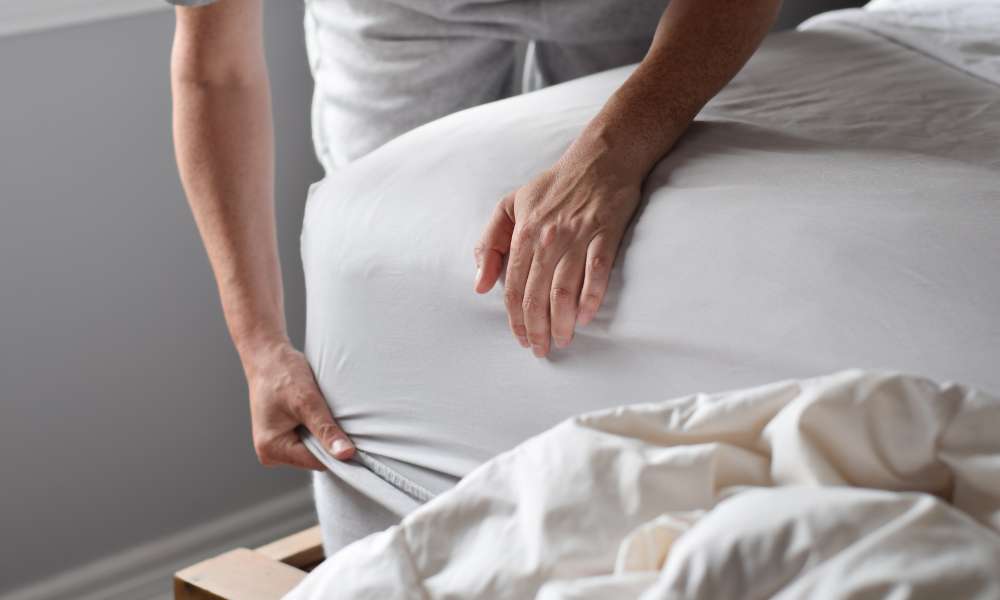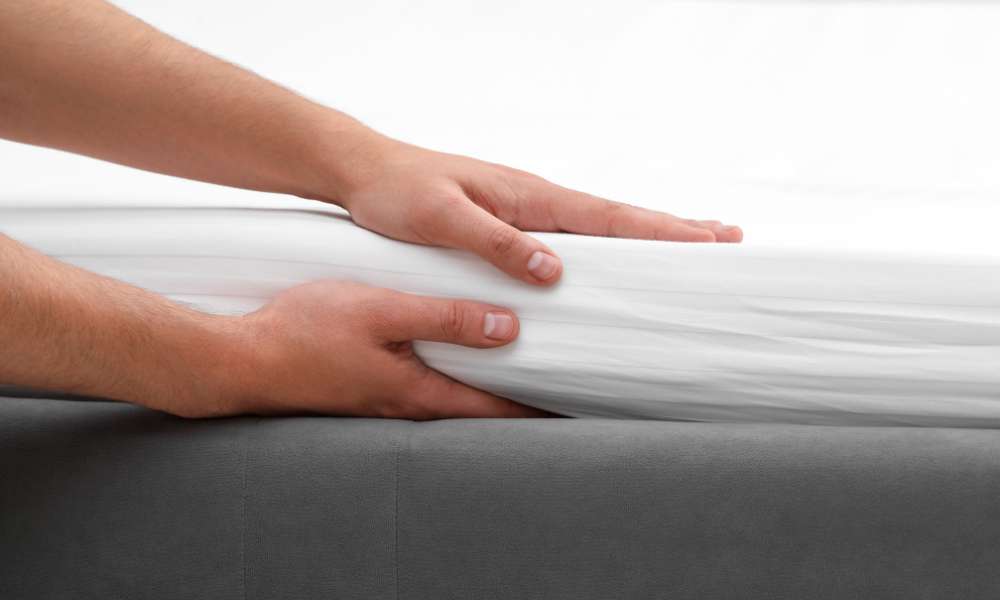Making your bed might seem like a simple task, but it’s an essential part of creating a comfortable and inviting space in your bedroom. The flat sheet, often overlooked, plays a key role in ensuring your bed looks tidy and feels cozy. In this guide, we’ll walk you through the step-by-step process to put a flat sheet on a mattress, providing detailed instructions to help you achieve a perfectly made bed every time. Whether you’re a bedding novice or someone looking to refine your technique, this guide has you covered.
Step 1: Choosing the Right Size for Your Flat Sheet

The first step in making your bed with a flat film is to ensure you have the correct size blanket for your mattress. Flat sheets come in a variety of sizes, typically ranging from Twin to California King. It’s important to choose the right size, as a sheet that’s too small won’t cover the mattress adequately, leaving you with gaps or exposed mattress edges. Conversely, a film that’s too large can result in excess fabric that bunches up, making it uncomfortable to sleep on and difficult to tuck in neatly.
When selecting your flat sheet, consider the depth of your mattress as well. Mattresses with added toppers or those that are extra thick may require a larger flat film or one specifically designed for deep mattresses. A well-fitted flat sheet should drape over the sides of the mattress with just enough fabric to tuck securely under the edges without excess. To avoid purchasing the wrong size, always check the dimensions of your mattress and compare them with the measurements of the film. This simple step ensures a smooth and hassle-free bed-making process.
Step 2: Laying the Flat Sheet Evenly Over the Mattress

Once you’ve selected the correct size, the next step is to lay the flat sheet evenly over the mattress. Start by spreading the film out, making sure the longer side aligns with the length of the bed. If your blanket has a decorative top edge or pattern, position it so that this edge is at the head of the bed, facing upwards. This detail not only enhances the aesthetic appeal but also ensures that when you fold the top over your blanket or comforter, the decorative edge is prominently displayed.
As you position the blanket, be mindful of keeping it centered. The sides and bottom of the film should drape evenly over the mattress. To achieve this, stand at the foot of the bed and adjust the film by pulling it gently from side to side until the overhang is equal on both sides. Centering the balnket is crucial because it prevents one side from having too much or too little fabric, which can lead to discomfort and an untidy appearance. Take your time with this step to ensure the film is laid out as flat and smooth as possible.
Step 3: Centering the Flat Sheet for Even Coverage

Achieving even coverage with your flat sheet is key to a well-made bed. After laying the sheet over the mattress, take a moment to ensure it’s properly centered. Stand at the foot of the bed and use both hands to gently tug the film until it’s evenly distributed on both sides. This step is often overlooked, but it’s crucial for a balanced and symmetrical look. A centered sheet will have equal amounts of fabric hanging over the sides of the mattress, which not only looks neat but also makes the next steps easier.
If you find that one side of the sheet is hanging lower than the other, simply adjust by pulling the blanket in the opposite direction. It’s better to make these adjustments now before you start tucking in the film, as it will save you time and effort later on. Centering the sheet also ensures that you have enough fabric on all sides to tuck under the mattress securely. This step may require a bit of patience, especially if you’re working with a larger film or a thick mattress, but the result is a bed that looks tidy and feels comfortable.
Step 4: Tucking in the Foot of the Sheet

With the sheet now centered on the mattress, it’s time to start tucking in the fabric, beginning at the foot of the bed. Tucking in the blanket at the foot of the bed is a crucial step for keeping the sheet secure and in place, ensuring it doesn’t come loose during the night. Begin by lifting the mattress slightly with one hand, just enough to slide the film under. With your other hand, take the bottom edge of the film and tuck it under the mattress, making sure it’s smooth and tight. This helps to create a clean, wrinkle-free surface that not only looks great but also enhances your comfort as you sleep.
As you tuck in the film, try to keep it taut by pulling the fabric towards you before tucking it under. This will help prevent any loose fabric from gathering under the mattress, which can cause discomfort. If you prefer a more secure fit, you can repeat this process on each side of the foot of the bed, tucking the film in tightly all the way to the corners. For a more relaxed look, you can leave the sides slightly looser. However, for a neat and polished appearance, it’s generally best to tuck the sheet in as snugly as possible.
Step 5: Mastering Hospital Corners for a Neat Finish
For those who want to take their bed-making skills to the next level, mastering the art of hospital corners is a must. Hospital corners are a technique that involves folding and tucking the sheet at the corners of the mattress in a way that creates a crisp, tight fit. This method not only looks incredibly tidy but also helps keep the blanket in place throughout the night. It’s a technique often used in hotels and hospitals to ensure beds are impeccably made.
To create hospital corners, start by standing at one corner at the foot of the bed. Lift the excess fabric of the sheet from the side, pulling it up to form a triangle. Hold the triangle in place, and then tuck the hanging portion of the blanket (below the triangle) under the mattress. Once the lower part is tucked in, fold the triangle down over the side of the mattress. Finally, tuck this piece of fabric under the mattress, smoothing it out as you go. Repeat this process on the other side of the foot of the bed.
Although hospital corners require a bit more effort, the result is a bed that not only looks professional but also feels more comfortable, as the sheet stays securely in place. This technique is particularly useful if you move around a lot during sleep, as it prevents the blanket from coming untucked. With practice, you’ll find that creating hospital corners becomes second nature, and your bed will have that neat, hotel-like finish that makes it all the more inviting.
Step 6: Smoothing Out the Sides of the Sheet

After you’ve secured the foot of the sheet, the next step is to focus on the sides of the bed. Smoothing out the sides is essential for creating a sleek, wrinkle-free surface. Begin by moving to one side of the bed and gently pulling the film outward to remove any slack or wrinkles. Once the blanket is smooth, tuck it under the mattress in the same way you did at the foot of the bed. Make sure to keep the sheet taut as you tuck it in, as this will help maintain the smooth appearance.
If you prefer a more tailored look, you can tuck the sheet in tightly all the way along the sides of the mattress. This approach gives the bed a crisp, clean look that’s perfect if you like your bedding to stay firmly in place. Alternatively, if you enjoy a bit more freedom of movement or prefer a more casual look, you can leave the sides untucked or tuck them in more loosely. This allows the sheet to move more freely, which some people find more comfortable, especially during warmer months when they may want to adjust their bedding more frequently during the night.
As you smooth out and tuck in the sides, take care to keep the film evenly distributed. This not only enhances the visual appeal but also ensures that the blanket stays in place and doesn’t bunch up during sleep. A well-tucked blanket also provides a stable base for your comforter or blanket, helping to keep your bedding layers neat and in alignment.
Step 7: Final Adjustments at the Head of the Bed

The last step in making your bed with a flat sheet is to make final adjustments at the head of the bed. This step involves ensuring that the top of the film is straight and aligned with the top edge of the mattress. If you’re planning to fold the blanket over your comforter or blanket, leave about 12 to 18 inches of fabric at the top. This allows you to create a neat, layered look that not only looks attractive but also adds an extra layer of warmth and comfort.
To achieve a polished appearance, smooth out the top of the sheet, making sure there are no wrinkles or folds. If your blanket has a decorative hem or edge, make sure it’s prominently displayed by folding the film over neatly. This small detail can make a big difference in the overall look of your bed, adding a touch of elegance and sophistication.
Once the top of the sheet is in place, take a step back and inspect your work. Make any final adjustments needed to ensure the blanket is smooth, centered, and evenly tucked. Afterward, you can add your comforter, blanket, and pillows to complete the bed. The flat blanket not only serves as a protective layer for your comforter but also enhances the comfort of your sleep environment by providing a soft, breathable layer between you and the heavier bedding.
Final Touches for a Perfect Bed
After you’ve successfully placed your flat sheet on the mattress, take a moment to appreciate your work. A well-made bed can transform the look and feel of your bedroom, making it a more inviting and relaxing space. Whether you prefer a tightly tucked, crisp look or a more relaxed, casual style, the key is to ensure that the blanket is smooth, evenly distributed, and
